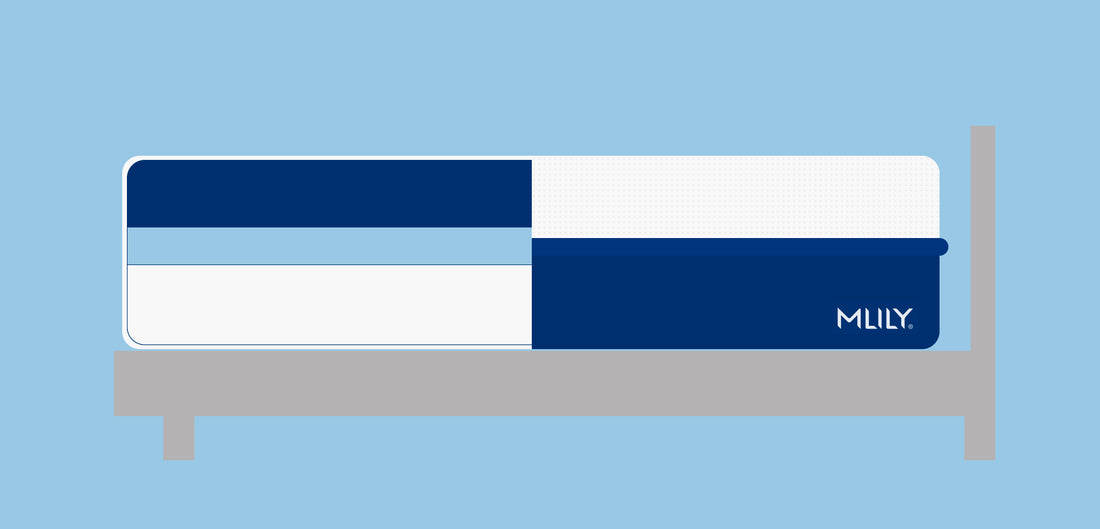
The memory foam manufacturing process involves many steps that turn petroleum products into the safe and pure flexible polyurethane foam that everyone knows and loves. Here’s what goes into making one of the world’s most popular mattress types.
Understanding Memory Foam
What is Memory Foam?
Memory foam goes by many names, including:
- Viscoelastic foam
- Flexible polyurethane foam
- Low-resistance polyurethane foam
All these names denote the properties of memory foam, namely, that it’s made of polyurethane (a type of synthetic resin) and it’s highly flexible. This elasticity is what makes memory foam mattresses so fantastic, as it enables the sleep surface to mold to your body in a way other materials cannot.
Memory Foam: Material for the Space Age

Memory foam might be a common bedding material now, but it has a much more exciting origin story. Memory foam was originally invented by NASA in the 1960s as part of their research to improve crash protection for pilots and astronauts.
The material was supposed to improve comfort during flight and provide superior cushioning during crashes because it could mold itself to the human body to distribute pressure evenly. This allowed it to provide better protection against extreme forces.
Once the recipe for memory foam was declassified, the bedding industry quickly got hold of it, making all sorts of improvements and modifications to turn memory foam into one of the most popular mattress materials used today.
Different Types of Memory Foam
In the early days, memory foam had some problems. The biggest issue was that this type of foam tends to overheat, so hot sleepers complained that they could not get a good night’s sleep on their memory foam mattress.
Now, many types of memory foam exist to help you sleep cooler, including:
- Gel-infused memory foam
- Copper memory foam
- Graphite memory foam
- Plant-based memory foam
- Open-cell memory foam
Virtually all modern memory foam is open-cell, meaning it has thousands of tiny bubbles inside it to circulate air for superior temperature regulation.
How a Memory Foam Mattress is Made
A lot goes into making memory foam. Manufacturers start with liquid ingredients and wind up with a new mattress.
Step 1: Preparing the Mixture
Memory foam starts out as raw liquid ingredients like polyols and isocyanates, as well as other additives. These chemicals react when mixed, forming the polyurethane that will eventually become memory foam.
Step 2: Stirring Things Up
The liquid polyurethane is whipped using a blowing or agitating agent. This helps blast bubbles into the foam, which creates the open-cell structure that helps keep it cool and breathable. Some memory foam may also be infused with gel beads or other cooling additives during this step of the process.
Step 3: Vacuum Sealing
Once the foam is ready for proofing, it gets poured into a mold and tightly sealed to cure. Vacuum sealing helps remove excess air and control the density and firmness of the final product.
Step 4: Proofing and Cooling
The foam mixture has to cool and cure just like bread. Depending on the intended density and firmness of the final product, the proofing process may take anywhere from a few hours to several days. The foam solidifies during this time.
Step 5: Post-Cure Cleanup
The solid memory foam is washed once it has finished curing (meaning the chemical reactions inside it have stopped). The washing process removes residue from the reactions that created the foam to ensure it is free from toxins and safe to sleep on.
Step 6: Cutting the Solid Foam
At this point, the memory foam is ready to be cut into appropriate shapes and sizes. For most memory foam mattresses, this means cutting the foam into chunks corresponding to the standard size run of twin through king.
Step 7: Putting It All Together
Like any type of mattress, memory foam mattresses have layers. For a pure memory foam mattress, several layers of different types of memory foam will be stacked on a firm base foam. For hybrids, one or more layers of memory foam will go on top of a pocketed coil support core.
Improving Memory Foam Mattresses
Memory foam mattresses offer many benefits, including pressure relief, contoured support, and improved sleep quality. However, traditional memory foam used to have a couple of problems, namely heat retention and body impressions.
Making a Memory Foam Mattress Cooler
One of the best ways to keep memory foam from retaining body heat is through ventilation. Nowadays, mattress companies use air channels, heat escape gussets, and patterned ventilation cutouts to keep cold air flowing through the mattress.
A fantastic example of cutting-edge ventilation features is the MLILY PowerCool Firm Sleep System. This ultra-cool sleep system features advanced sleep technology that combines small and large air channels and cooling fans to keep the sleep surface pleasantly chilly – perfect for sleepers with night sweats!
Making a Memory Foam Mattress Firmer
The best memory foam retains its flexibility while providing support. Unlike natural latex, synthetic memory foam usually needs a little boost. Most of the time, this boost comes from an ultra-firm support layer, like that found in the MLILY WellFlex 1.0.
One of our firmest memory foam mattresses, the WellFlex boasts a base layer of highly supportive Flex Support Foam. This high-grade foam supports the softer upper layers of the mattress to provide lots of lift without sacrificing contour.
Can I Make a Memory Foam Mattress at Home?
Of course, you probably can’t make memory foam yourself, but you can make a DIY memory foam mattress with premade foam.
Even so, we recommend going with mattresses that have been professionally designed and constructed because these are typically more durable, and they’re also optimized for spinal support.
If, however, you’re just dying to build your own mattress, you’ll need to keep a few things in mind:
Choosing the Right Foam Density and Thickness for Individual Sleep Preferences
You’ll need to choose your firmness, density, and thickness based on factors like your body weight and sleep position preference.
If you’re heavier or sleep on your stomach, you’ll likely need more support; therefore, consider a thicker, denser mattress. Lighter sleepers and side sleepers may need softer mattresses with more contouring, so they’ll want to avoid highdensity and look into plushier options.
Properly Aligning the Foam Layers for Optimal Comfort and Support
If the foam layers are not aligned, the mattress will look like a sandwich with the filling falling out. Even worse, its spinal support will wind up being inadequate. So make sure everything is stacked neatly.
Applying Adhesive Evenly to Prevent Problems in the Long Run
Adhesive is one of the most important parts of the mattress. You’ll need to apply appropriate foam adhesive in between all the layers. Let it dry before zipping the layers inside your cover.
Considering a Mattress Topper for Added Comfort
Mattress pads can help add an extra layer of contouring to your sleep surface. Remember that mattress toppers usually go outside the cover but under the mattress protector, though you can add one underneath the cover to enhance your comfort layer if you like.
Conclusion
For an amazing sleep experience, look no further than a memory foam mattress. These mattresses are durable, comfortable, and affordable – all because they’re easy to manufacture with readily available ingredients. Check out our products to find your perfect memory foam mattress for restful nights of sleep!
